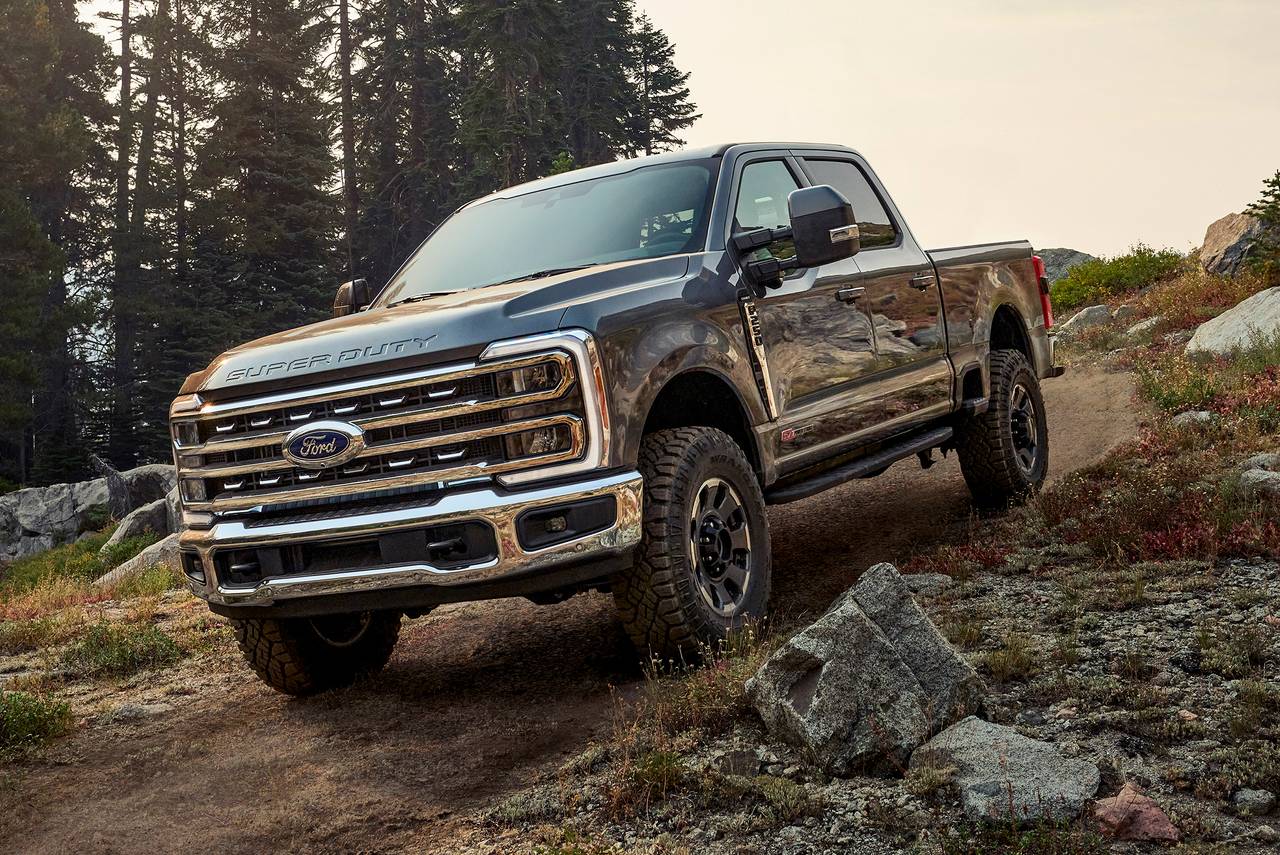Sooner or later, everyone needs a pickup. It might be once, or it might be daily, but eventually, you'll find yourself wishing for a vehicle that can tow, haul, and accommodate large items like furniture, appliances and yard materials. Or maybe you'll just want something that can climb to the top of a mountain peak for an unforgettable view. Whether for work or play, trucks are downright handy, simplifying complex tasks and making your life easier.
Pickups range from basic work trucks that seat just two or three passengers to luxurious five-passenger heavy-duty models that can cost over $100,000. Between these extremes is a vast range of sizes, cab configurations, trim packages and powertrains to serve nearly any purpose. Before you make your choice, it's essential to understand how you'll use your pickup and what features are most important to you. The right truck will tackle any task you require, while the wrong one can result in dissatisfaction. Our Edmunds Truck Buying Guide is here to help make sure you find one that you can love rather than settle for one that you might regret. Here are a few basics to consider in your search for a new truck:
Jump to:
- Cab and bed designs
- Price
- Performance and MPG
- Drivetrain
- Roominess
- Towing and payload
- Safety
- Cost to own
Cab and bed designs
There are three main cab designs: regular cab, extended cab and crew cab. Truck manufacturers often have different names for these types, but they will always fall within these categories.
Regular-cab trucks have two doors, seat two or three people, and offer a small amount of in-cab storage.
Extended-cab trucks also have two doors but a larger cab that can seat up to six people. The rear seats — usually just small jump seats — can be cramped for passengers, so the primary benefit of an extended cab is for storing more cargo in the locked, weathertight interior.
Crew-cab trucks have four doors and can seat up to six people, but they offer more generous rear passenger space. Some automakers also offer two sizes of crew-cab designs.
Trucks are typically sold with either a short bed or a long bed. There's no standardized measurement tied to each, though most short beds are around 6 feet in length and long beds are around 8 feet. Short beds typically keep the truck's overall length shorter, which helps with maneuverability, while long beds increase cargo space at the expense of either cab space or maneuverability.
Price
The benefit of so many truck configurations is that you can tailor most of them with optional equipment, including everything from luxury amenities to auxiliary lights and accessories. They can be weekday workhorses, weekend adventurers, and reflections of your personality every day. On the other hand, while base prices might range from about $23,000 for a basic small truck to $48,000 for a bare-bones heavy-duty crew cab, you can easily spend double those figures for fully loaded models equipped with all of the extras.
Performance and MPG
Modern trucks come with gas, diesel, hybrid or fully electric powertrains. Conventional engines range from four-cylinder to V8 configurations and are typically either turbocharged or naturally aspirated (aka non-turbocharged). Most trucks usually come with at least two engine choices, allowing you to pick one that best suits your needs. You might pick a four-cylinder engine for the best fuel economy, for instance, or a beefy V8 or turbocharged V6 for strong acceleration and towing capability. The optional diesel engines in heavy-duty trucks are specifically designed for towing performance. Electric truck powertrains are a relatively new development, but the few models currently on the market offer robust strength and prodigious torque output to handle most truck tasks.
Drivetrain
If you prefer to shift your own gears, a handful of trucks offer a manual transmission, including the latest Toyota Tacoma. But the majority roll out of the factory with an automatic. Nearly all trucks come standard with two-wheel drive (2WD) and offer optional four-wheel drive (4WD). Typically, a 2WD truck can tow and haul more weight, but if you're planning to go off-road, you'll want 4WD.
Some 4WD trucks have a manual two-speed transfer case, while others offer shift-on-the-fly electronic 4WD. The low-range gearing available from a two-speed transfer case can be helpful when off-roading. Automatic 4WD is also available, engaging whenever reduced traction requires it. Limited-slip or locking differentials and driver-selectable electronic presets optimized for terrain and conditions also help maximize off-road traction.
Roominess
A crew cab gives you the most space for people and cargo you'd rather not store in the cargo bed. At a minimum, a regular-cab pickup seats two people, or three if you choose one with a bench-style front seat. Extended cabs have rear jump seats or a small rear bench seat designed to occasionally accommodate passengers. Crew cabs offer expansive rear seating, with the largest trucks offering enough room for tall passengers to stretch their legs and relax.
Towing and payload
Two of the main reasons to buy a pickup truck are towing and hauling capabilities. Across all truck classes, though, the numbers vary, and dramatically so. Broadly speaking, small trucks top out at around 5,000 pounds of maximum towing capacity, while midsize trucks range from around 5,000 to 7,000 pounds. Light-duty full-size trucks max out at around 12,000 to 13,000 pounds.
Heavy-duty trucks, with their more robust construction and available diesel engines, can pull upward of 35,000 pounds, depending on model and configuration. Newer electric trucks are limited by battery capacity and range but can still pull around 10,000 pounds, a useful number for many tasks.
Payload capacities — the maximum weight of stuff you can put in the bed — are also highly variable, even within a singular pickup's range of configurations. As with towing capacity, heavy-duty trucks can handle the most payload. Knowing what you expect to do with a truck dictates the right one to serve your needs.
Take a look at our Best Trucks for Towing story for more detailed information on which trucks have the highest tow ratings.
Safety
When it comes to safety, trucks are more sophisticated than ever, available with the latest advanced driver assistance systems and connected services that can provide immediate help when necessary. Numerous trailer-towing features, such as sensors that monitor a trailer's blind spots, also make modern trucks safer to drive. The newest designs also tend to perform well in crash tests conducted by the National Highway Traffic Safety Administration and Insurance Institute for Highway Safety, so be sure to compare safety ratings if this is an important factor in your decision.
Cost to own
The more capable a truck is, the more expensive it will likely be to own. Bigger and more powerful engines typically consume more fuel, and while diesel engine options are efficient, they're usually more expensive up front. 4WD systems and specialty off-road versions also add cost. More expensive trucks also typically cost more to insure. Edmunds has a True Cost to Own calculator that can help you see the differences in ownership costs between models.
Next steps
Now that you know the basics to consider, take a look at Edmunds' trucks rating page, where you can find rankings of the best trucks on the market in any size.

 by
by